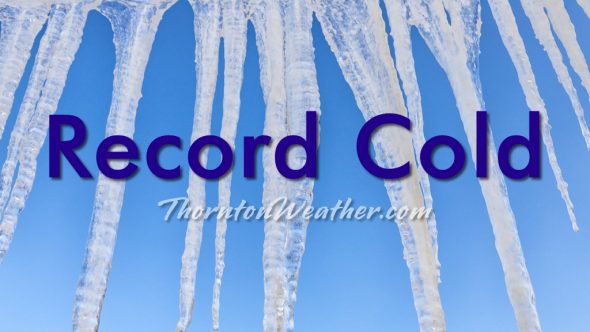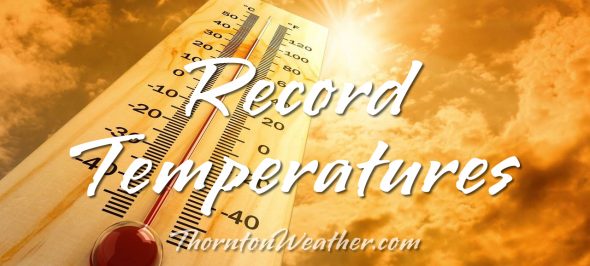
Think we are done with snow for the season? That may be the case this year but it isn’t always so. Looking back at this week in Denver history we do see snowfall has occurred along with more typical spring weather including heavy rains that led to flooding.
From the National Weather Service:
4-8
In 1969…heavy rains caused flooding on Boulder creek in Boulder…which resulted in one death on the 7th. Flooding also occurred on Bear Creek in Sheridan and on the South Platte River in Denver. Rain over most of the eastern foothills started late on the 4th and continued with only brief interruptions in many areas until the morning of the 8th. Very high rates of rainfall occurred on the 6th and 7th with the greatest intensities in a band along the foothills from about 25 miles southwest of Denver northward to Estes Park. Storm totals by both official and unofficial measurements exceeded 10 inches over much of this area and were over 12 inches in some localities. Heavy snow fell in the higher mountains and in the foothills later in the period. The saturation of the soil resulted in numerous rock and land slides…and the heavy run-off caused severe damage along many streams and flooding on the South Platte River. Many foothill communities were isolated as highways were blocked and communications disrupted. Roads were severely damaged over a wide area…and a large number of bridges washed out. Many roads were closed due to the danger from falling rocks. A building in Georgetown collapsed from the weight of heavy wet snow. In Boulder…a man drowned when caught by the flooding waters of Boulder Creek…and a patrolman was injured. Rainfall totaled 7.60 inches in Boulder with 9.34 inches recorded at the Public Service Company electric plant in Boulder Canyon. In Morrison…rainfall totaled 11.27 inches in 4 days. Heavy rainfall totaled 4.68 inches at Stapleton International Airport over 3 days from the 5th through the 7th. Rainfall of 3.14 inches was recorded in 24 hours on the 6th and 7th. Downstream flooding continued along the South Platte River until the 12th when the flood crest reached the Nebraska line.
7-8
In 1958…rainfall totaled 2.50 inches at Stapleton Airport.
8
In 1873…a very light rain fell until 5:00 am…when it turned into light snow and sleet and was accompanied by brisk northeast winds. The snow froze as it fell… Breaking the telegraph lines in many places. Precipitation totaled only 0.14 inch in the city.
In 1883…a severe rain and hailstorm struck the city. In 25 minutes the hail was 5 inches deep in the vicinity of the weather office in downtown Denver and reported as deep as 10 to 12 inches in other parts of the city. Gutters were blocked by the hail…and many cellars were flooded. Precipitation from the storm was 1.90 inches with the total for the day recorded at 2.02 inches. The size of the hail was not recorded.
In 1988…a wind gust to 68 mph was recorded at Echo Lake. Northwest winds gusted to 35 mph at Stapleton Airport.
In 1995…high winds of unknown strength blew a camper shell from the back of a pickup truck near Fort Lupton. North winds gusted to 49 mph at Denver International Airport.
In 1996…1 to 2 inch diameter hail was measured in Lochbuie northeast of Denver. Bean size hail fell in Brighton. The large hail fell from severe thunderstorms to the northeast of metro Denver.
In 2003…tornadoes touched down briefly near Brighton… Watkins…and Strasburg…but did no reported damage. Hail to 3/4 inch in diameter was measured near Hudson.
In 2017…severe thunderstorms broke out across Denver and the surrounding metro area and produced large damaging hail…strong winds…heavy rain and flash flooding. Hail up to baseball size…caused extensive property damage to cars…homes and businesses across a large part of Denver and the western suburbs including Arvada…Lakewood and Wheat Ridge. According to the Rocky Mountain Insurance Agency Association…the storm was Colorados most expensive insured catastrophe…around $2.3 billion. The group estimated more than 150000 auto insurance claims and 50000 homeowner insurance claims would be filed. Businesses and homes sustained holes in siding along with broken windows and torn screens. Severe thunderstorm producing large hail…strong winds and heavy rain impacted areas around Greeley as well. The high cost incurred from the storm was due to a number of factors including: the size of the hail…the densely populated area…the time of day…the escalating costs to repair high-tech cars…and more expensive homes. Colorado Mills Mall in Lakewood was severely damaged after hail busted skylights and caused flooding inside stores. The common areas and tenant spaces suffered substantial water damage. Extensive damage to electrical systems…mechanical systems… including HVAC and lighting…were expected to keep the mall closed for several months. In Lakewood…the loss in sales tax was projected to be about $350000 per month…which was 3 to 4 percent of the city`s monthly budget. Prestige Imports in Lakewood which sells Audis and Porches…250 to 300 vehicles were impacted by the storm. Some of those vehicles were valued at nearly $200000 each. Significant damage was reported at Lutheran Medical Center after the hailstorm tore through Wheat Ridge. The hospital building and some of the medical office buildings sustained broken windows. The storm also hit the office of the Colorado Bureau of Investigation in Lakewood. The offices were flooded…several cubicles destroyed…and even some ceiling tiles fell off. The storm damage prompted school officials to close all thirteen Adams 12 Five Star schools in Commerce City and Beach Court Elementary school in Denver. Most of the schools in the Adams 12 Five Star District were at least 50 years old and sustained flood damage. Large hail damaged an apartment building near Regis University… shattered windows and punctured the siding on the west-facing side of the building. Hail and heavy rain clogged drains and caused flash flooding throughout Greeley. Up to three feet of water covered the roadway near U.S. 34 and U.S. 85. Greeley firefighters helped several residents get out of garden level apartments that had flooded. Several other businesses and buildings suffered flood damage… including Greeley City Hall and an apartment complex in Evans. The Greeley Mall was extensively damaged when water poured into the mall from the roof and debris inundated the main floor.
8-9
In 1957…intense heavy rain caused flash flooding on toll gate creek in Aurora where 3 people were killed in a car. Up to 4 inches of rain fell in 5 hours in the Toll Gate Creek basin. The rain also caused flash flooding on sand creek in Aurora and Denver. Rainfall totaled 3.29 inches at Stapleton Airport with most of the rain…2.34 inches… Occurring on the 9th.
8-10
In 1979…4.3 inches of snow fell at Stapleton International Airport where northwest winds gusted to 30 mph on the 8th. Most of the snowfall…2.3 inches…occurred on the 9th. High temperature of only 35 degrees on the 9th equaled the record low maximum for the date.
9
In 1875…a heavy windstorm swept across the city for most of the day. West-northwest winds averaged a sustained speed of 31 mph between 6:00 am and 3:00 pm. The peak wind was sustained to 45 mph at 9:50 am.
In 1918…post-frontal winds were sustained to 40 mph with gusts as high as 43 mph. Only a trace of rain fell.
In 1941…a tornado was noted at 2:20 pm to the northeast of downtown and was followed by another similar shaped cloud or dust roll estimated 3 miles behind. Thick dust followed with heavy gusts of wind. The temperature fell 15 degrees in 10 minutes following the twister. The mild tornado did little damage except to unprotected frame structures. Winds were sustained to 50 mph with the passing of the tornado at Stapleton Airport. It was visible to observers for 10 minutes and was lost from sight as it traveled east into huge rolls of dust. Hail and rain followed with a few hailstones as large as 1/2 inch in diameter downtown. No damage was reported from the hail. Thunderstorm winds sustained to 31 mph produced blowing dust downtown. Precipitation was only 0.07 inch.
In 1983…streams swollen by recent rain and snowmelt caused an earthen dam to collapse…washing out portions of State Highway 67 near Deckers in southern Douglas County.
In 1992…three boys…ages 11…12…and 16…were struck by lightning while taking cover under a large tree during a thunderstorm in Jefferson County…just 7 miles northwest of Denver. The three were seriously injured.
9-10
In 1889…heavy rainfall totaled 2.15 inches in downtown Denver. The cold rain was mixed with snow at times overnight. Temperatures on the 10th ranged from a high of 38 degrees to a low of 32 degrees with north winds sustained to 22 mph.
In 2003…a late spring snowstorm hammered the mountains… Eastern foothills…and urban corridor. The heaviest snowfall occurred north of interstate 70. The heavy wet snow caused damage to trees throughout metro Denver and downed power lines. About 40 thousand people along the urban corridor were without power. Storm total snowfall amounts included: 11.5 inches in Louisville… 8 inches in Boulder and Broomfield; 7 inches in Thornton…Broomfield…at Denver International Airport… And at the site of the former Stapleton International Airport; and 6 inches 4 miles east of Denver. Snowfall ranged from 4 to 9 inches across extreme southern weld County. In the foothills…15 inches of snow fell near Jamestown…9 inches at Rollinsville and Rawah…with 8 inches at Chief Hosa and atop Lookout Mountain. The snow was accompanied by thunder on the afternoon of the 9th at Denver International Airport where west winds gusted to 25 mph on the 9th and north winds gusted to 22 mph on the 10th.
10
In 1875…a windstorm sand-blasted the city from 10:00 am until midnight. Northwest winds sustained to 60 mph brought clouds of sand…which caused high damage to unfinished buildings.
In 1912…a vigorous cold front produced strong north winds and rain. North winds were sustained to 48 mph with gusts as high as 60 mph. Rainfall totaled 1.10 inch.
In 1935…no precipitation occurred…making this one of only two days without precipitation during the entire month. The other day was the 21st. Precipitation totaled 4.95 inches for the month.
In 1956…northwest winds gusted to 53 mph at Stapleton Airport where the visibility was briefly reduced to 1/2 mile in blowing dust.
In 1974…strong winds caused 30 thousand dollars in damage to a building under construction in Lakewood. Microburst winds gusted to 46 mph at Stapleton International Airport.
In 1988…lightning struck a house in Boulder…setting it afire. The house…valued at 170 thousand dollars…was a total loss.
In 1989…golf ball size hail fell over southeast Denver near the junction of I-25 and I-225. Hail to 3/4 inch in diameter fell over southeast Aurora. Only 3/8 inch hail fell at Stapleton International Airport.
In 1991…high winds up to 63 mph raked the eastern foothills. Winds estimated to 50 mph tore a roof from a home in Lafayette. A tower at Jefferson County stadium in west metro Denver was blown over by the high winds. No injuries were reported. Southeast winds gusting to 48 mph at Stapleton International Airport produced some blowing dust. The temperature climbed to a high of 86 degrees… Equaling the record maximum for the date.
In 2005…severe thunderstorms produced hail as large as 2 inches in diameter in and near Longmont.
10-11 in 1918…post-frontal snowfall totaled 4.7 inches in downtown Denver. Northwest winds gusted to 19 mph on the 10th.
In 1923…winds were strong and gusty on both days. Northwest winds were sustained to 40 mph with gusts to 44 mph on the 10th. North winds were sustained to 39 mph with gusts to 46 mph behind an apparent cold front on the 11th.
10-12
In 2011…a spring snowstorm brought heavy snow to the Front Range Foothills and Palmer Divide. Storm totals included: 18 inches…4 miles south-southeast of Pinecliffe; 16 inches in Coal Creek Canyon; 15 inches…4 miles west-southwest of Eldorado Springs; 13 inches at Gold Hill…12 inches…4 miles west-southwest of Conifer and 4 miles northwest of Elizabeth; 11.5 inches…6 miles southwest of Evergreen and 4 miles east-northeast of Nederland; 11 inches…3 miles east of Jamestown and 10.5 inches…3 miles east of Franktown and 3 miles south of Golden and 10 inches…10 miles north of Elizabeth. At Denver International Airport…1 inch of snowfall was observed.
11
In 1879…an apparent cold front during the afternoon produced sustained north winds as high as 60 mph and great clouds of blowing dust. The dust filled the air until the thunderstorm rain began…which produced 1.46 inches of rainfall. The rain ended during the evening.
In 1900…southwest winds were sustained to 40 mph with gusts to 46 mph.
In 1958…a microburst caused a brief wind gust to 55 mph at Stapleton Airport.
In 1963…south-southwest winds gusted to 48 mph at Stapleton Airport. Winds May have been stronger over west Denver where some buildings were damaged.
In 1998…large hail fell over south metro Denver. Hail as large as 1 1/4 inches in diameter was measured in Parker with 1 inch hail recorded in Littleton and 4 miles south of Lakewood in Jefferson County. Hail to 3/4 inch diameter was measured in Douglas County…11 miles west- northwest of Parker.
Continue reading May 8 to May 14: This week in Denver weather history →
 Extreme weather can occur during in month in Colorado we well know. June however is when traditional spring severe weather arrives in the state oftentimes with hail, damaging wind and tornadoes.
Extreme weather can occur during in month in Colorado we well know. June however is when traditional spring severe weather arrives in the state oftentimes with hail, damaging wind and tornadoes.




